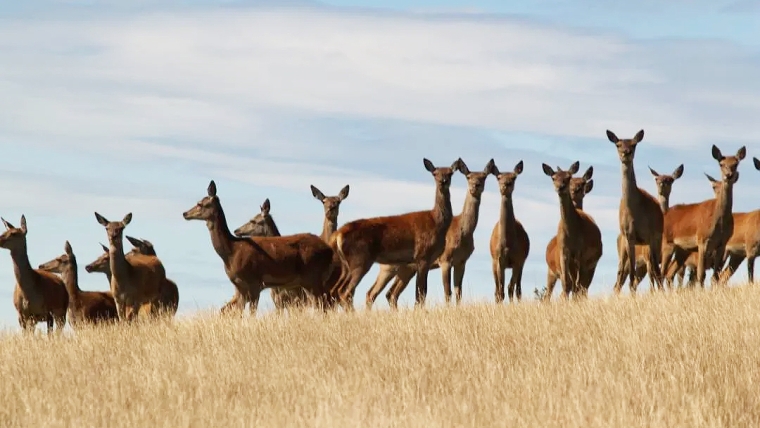
Deer have long carried a reputation for being difficult to handle, destructive on fences and volatile in the marketplace. But as farmer and consultant Matt Carroll points out, much of that reputation is now out of date. Modern deer are calmer, infrastructure requirements are not as daunting as some believe and the financial comparisons with sheep and beef stack up better than many expect. For those who already have the infrastructure in place, there may be fresh opportunities to diversify farm systems and spread risk.
Matt farms in the Pohangina Valley with Westview Farming Partnership, where he holds a supervisory role across sheep, beef and deer, while also working with BakerAg from their Feilding office. He says the door is open for more farmers to look again at deer, especially those who still have deer blocks or fencing from earlier decades. “There’s a real opportunity out there and it has been for a few years, for people who have got the deer infrastructure on the farm already,” he says. “If you don’t have deer on the place currently or there has been in the past, the deer we farm nowadays are very different to what was farmed previously. A breeding hind operation especially if you’re hill country, is basically the same labour requirement as beef cows. And the financials are definitely there.”
That change in temperament cannot be understated. Deer handling is a far cry from the bruises and chaos many remember from the 1990s. Today, selection for calmer animals and better husbandry means deer can be managed with far less stress. In many cases, Matt says, farmers are successfully running velvet stags behind simple electric fences. “Like most stock, if they’re well looked after and there’s good feed available to them, they’re not really going to be giving the fences a hard time.”
The financials are also compelling. BakerAg recently compared breeding and finishing deer with sheep and beef systems. “The deer breeders at store were looking at $131 a stock unit and the breeder finishes $147 a stock unit,” Matt says. “That compares pretty well with a high-performing sheep flock at $150 to $160, or a high-performing cattle herd at $110 to $130. So it shows they do have a place to slot in. And remember the deer don’t need shearing, crutching, or dagging so the costs are lower.”
As with other livestock sectors, the market has had its share of volatility. But Matt believes deer are unfairly singled out. “Uncertainty is basically the only certainty we’ve got in farming,” he says. “Volatility is just farming. Deer unfairly get a bad rap for that, but what’s happened in the last little while is the stability is getting really good.”
That stability is showing through in fixed-term contracts for venison, some stretching as long as two years. Farmers know exactly what they will be paid regardless of seasonal swings. “We don’t have suppliers saying we’re going to pay you this much for your lamb fixed throughout the season,” Matt notes. “But venison contracts are doing exactly that. And when you add in the premiums - up to $1.20 a kilo above the advertised schedule, the returns are well worth it.”
Velvet too remains a strong opportunity, though the entry requirements are higher. Farmers need accredited facilities, audited annually and must comply with food-grade standards and traceability systems. “Velvet has pulled people in because the money in the past was good, but if you’re chasing the ups it’s easy to be stung,” Matt warns. “If you’re just getting into deer my recommendation would be to prove yourself running hinds first. Learn to appreciate the animal, get your head around their quirks and then velveting can be a stepping stone you take after that.”
One of the biggest advantages of deer is how they complement other stock classes. Their feed demand peaks in summer rather than spring, easing pressure when ewes and cows are at their hungriest. “It spreads the load and it spreads the risk,” Matt explains. “In hill country systems, when spring kicks into gear the key driver is the condition of your animals. The benefit of having hinds is they’re not competing for that spring demand. They come into peak demand in summer, which balances things out.”
Parasite management is another area where deer bring benefits, thanks to inter-species grazing. “If you had, say, 100 hectares of deer fencing on your property we wouldn’t recommend you completely load that up with deer,” Matt says. “You want to be running that at 70% capacity so that you’ve got other animals to come in and graze. It’s a different species, another mouth which helps.”
Labour requirements are also favourable compared with sheep. For older farmers or smaller operators unable to justify a full staff unit, deer can be an option that reduces workload while still maintaining income. “I’m not anti-sheep at all, but I think being diversified just takes the risk away from your business,” Matt says. “You don’t often have a year where everything is down. If velvet’s down, sheep or beef might be up that’s where you get the benefit.”
The deer industry itself is still young. Farming only began in earnest in the 1970s, when wild deer were captured by helicopter in a pioneering era often described as New Zealand’s Wild West. Since then, the industry has endured setbacks and volatility but it has also shown resilience and innovation. “This industry has just been made on people finding an opportunity, getting hit while they’re down but standing back up again and moving on,” Matt says. “That’s just Kiwi farming - don’t give up just keep going.”
Looking ahead, farmers interested in exploring deer have a chance to learn more. Two workshops are planned in Te Pōhue, Hawke’s Bay on 7 October and Pohangina, Manawatū on 11 November. These will bring together Beef + Lamb New Zealand, Deer Industry New Zealand and the Deer Farmers’ Association with farmer panels and expert input. As Matt puts it: “If you’re thinking about it and you’ve got the infrastructure there and you’re looking to spread the risk within your business, then I’d highly recommend coming along.”
Deer farming may not be for everyone, but with improved animal temperament, stronger market stability, and financial returns that stack up well alongside sheep and beef, the industry deserves another look. For farmers with the infrastructure in place and an eye on diversification, the time may be right.
Have a listen to the podcast to hear the full story.
Angus Kebbell is the Producer at Tailwind Media. You can contact him here.

We welcome your comments below. If you are not already registered, please register to comment
Remember we welcome robust, respectful and insightful debate. We don't welcome abusive or defamatory comments and will de-register those repeatedly making such comments. Our current comment policy is here.